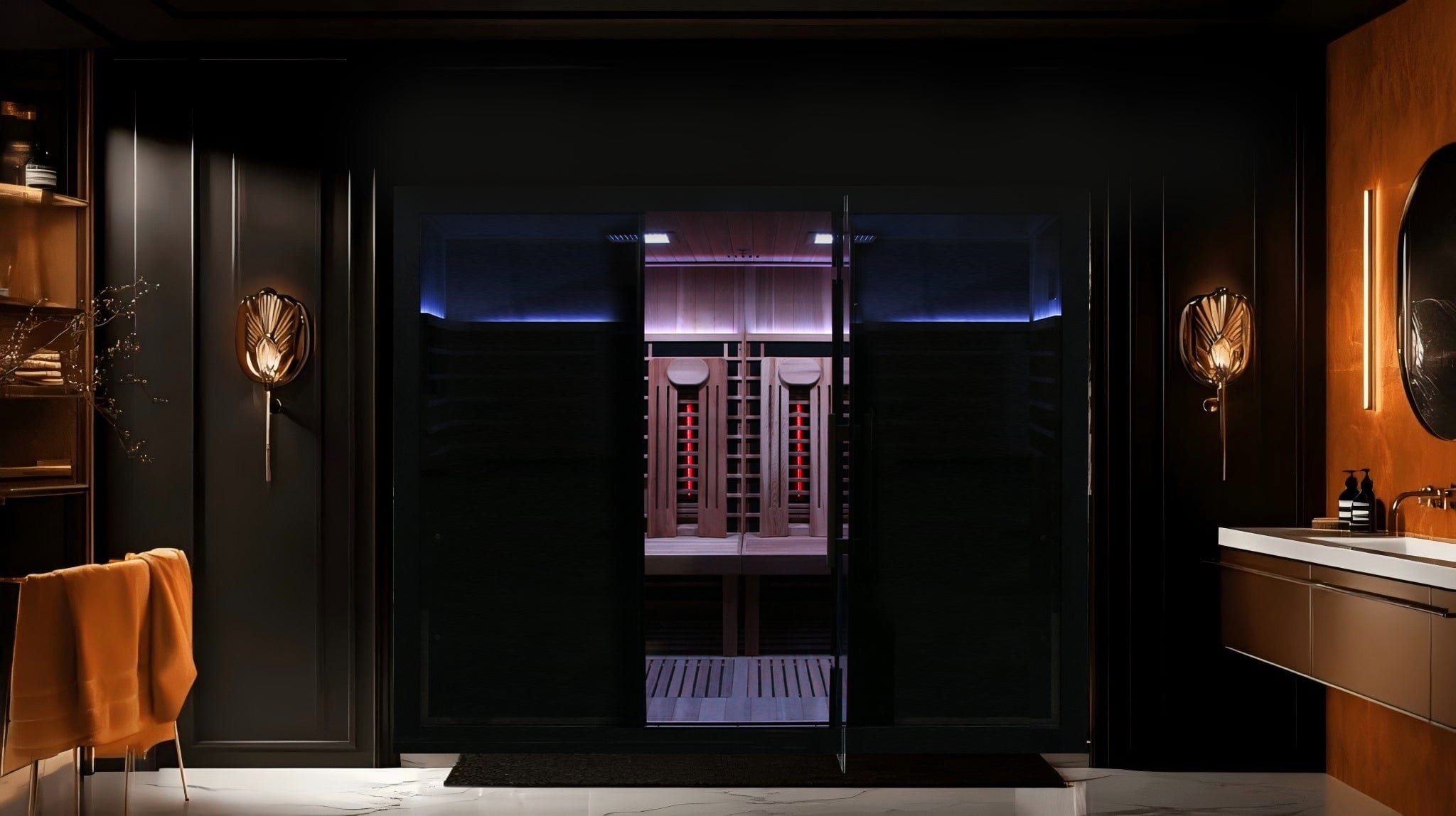
Home Sauna FAQ
 What is an infrared sauna and how does it work?
What is an infrared sauna and how does it work?
Infrared saunas use light wavelengths (near, mid, far) to heat the body directly instead of heating the air first. This can feel gentler while still promoting circulation, relaxation, and a healthy sweat.
 What’s the difference between near, mid, and far infrared?
What’s the difference between near, mid, and far infrared?
Near IR focuses more superficially and is often associated with skin/mitochondrial effects, mid IR targets soft tissue, and far IR provides deep, overall warmth. Full-spectrum units combine all three.
 Is an infrared sauna the same as a red-light device?
Is an infrared sauna the same as a red-light device?
No. Red-light therapy uses visible red/near-IR for photobiomodulation without heat. Infrared saunas use primarily IR heat for thermal effects; some models also include red-light panels.
 What does low EMF mean in an infrared sauna?
What does low EMF mean in an infrared sauna?
Low EMF indicates reduced electromagnetic fields around heaters and wiring. Look for independent testing, shielding, and published EMF readings near user seating areas.
 What temperature should I use?
What temperature should I use?
Common ranges are 110–140°F (43–60°C). Start lower and increase gradually based on comfort and session goals.
 How long should sessions be?
How long should sessions be?
Beginners often start with 10–15 minutes and build up to 20–30 minutes. Hydrate well and listen to your body.
 Are infrared saunas energy efficient?
Are infrared saunas energy efficient?
Typically yes. They warm up faster and often use less electricity than many traditional units at comparable session lengths.
 Can I combine infrared with traditional steam?
Can I combine infrared with traditional steam?
Not in the same enclosure unless the manufacturer designs for hybrid use. Moisture near IR emitters can be unsafe—follow the product’s instructions.
 How do I verify safety claims?
How do I verify safety claims?
Ask for third-party test reports: EMF readings, safety certifications (UL/ETL), low-VOC materials, and published electrical specs.
 Who shouldn’t use infrared saunas?
Who shouldn’t use infrared saunas?
People with certain medical conditions, those pregnant, and anyone on heat-sensitivity medications should consult a clinician first.
Traditional FAQ
 How does a traditional sauna work?
How does a traditional sauna work?
It heats the air (often 160–195°F / 71–90°C). You can add steam by pouring water on hot rocks to raise humidity.
 What’s the difference between Finnish, electric, wood-burning, and steam rooms?
What’s the difference between Finnish, electric, wood-burning, and steam rooms?
Finnish saunas use dry heat with optional steam bursts; electric and wood-burning are heat sources for Finnish style; steam rooms run at lower temps with near-100% humidity.
 Which wood is best?
Which wood is best?
Cedar, hemlock, and basswood are common. Choose kiln-dried, low-resin, low-VOC woods from reputable suppliers.
 Do I need ventilation?
Do I need ventilation?
Yes. Proper intake and exhaust improve comfort, air quality, and wood longevity.
 How long should I stay?
How long should I stay?
Many users do 10–20 minute rounds with cool-down in between. Start shorter and never push past comfort.
 Can I use essential oils?
Can I use essential oils?
Beginners often start with 10–15 minutes and build up to 20–30 minutes. Hydrate well and listen to your body.
 What maintenance is required?
What maintenance is required?
Wipe benches after use, keep floors clean, ensure ventilation, and periodically check heaters, stones, and electrical connections.
 Can I install a traditional sauna in an apartment?
Can I install a traditional sauna in an apartment?
Smaller electric units may be feasible. Always check electrical capacity, ventilation, building codes, and HOA rules.
Safety and Use FAQ
 How often should I use a sauna?
How often should I use a sauna?
Many people benefit from 2–4 sessions per week. Some experienced users go more frequently. Hydration and recovery matter most.
 What are signs I should end a session?
What are signs I should end a session?
Lightheadedness, nausea, dizziness, or unusual discomfort. Step out, hydrate, and cool down.
 What should I drink or eat before a session?
What should I drink or eat before a session?
Hydrate with water or electrolytes. Avoid heavy meals and alcohol beforehand.
 Is it safe to sauna after workouts?
Is it safe to sauna after workouts?
Many people do. Let your heart rate come down first, then keep your first heat round shorter.
 Can saunas help with sleep and stress?
Can saunas help with sleep and stress?
Many users report improved relaxation and sleep quality. Individual results vary.
 What should I wear?
What should I wear?
Breathable, clean materials or a towel. Avoid lotions or products that may outgas at heat.
 How do I keep my sauna sanitary?
How do I keep my sauna sanitary?
Use towels on benches, wipe surfaces after sessions, clean floors, and ensure airflow to deter moisture buildup.
 What certifications matter?
What certifications matter?
Electrical safety (UL/ETL/CE), low-VOC materials, and documented EMF testing for infrared systems.
 Can kids use a sauna?
Can kids use a sauna?
Only with a clinician’s guidance and close supervision, at lower temps and shorter durations.
 Are there contraindications?
Are there contraindications?
Yes. Certain cardiovascular conditions, pregnancy, heat-sensitive medical issues, and some medications. Consult a clinician first.
 What is an infrared sauna and how does it work?
What is an infrared sauna and how does it work?
 How does a traditional sauna work?
How does a traditional sauna work?